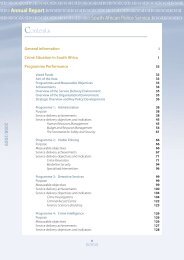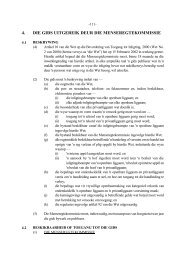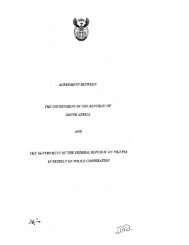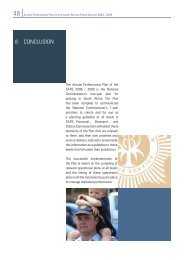Part 13 - Saps
Part 13 - Saps
Part 13 - Saps
You also want an ePaper? Increase the reach of your titles
YUMPU automatically turns print PDFs into web optimized ePapers that Google loves.
310<br />
established that almost 43% resulted in a conviction. In comparison, in the CIAC’s sample<br />
only just over 6% of recorded urban ‘house robberies’ resulted in a conviction. 3<br />
The CIAC has also made a comparative study between ‘house robberies’ on farms and<br />
those in urban areas in respect of the four provinces with the highest proportion of house<br />
robberies on farms, viz. Free State, Limpopo, Mpumalanga and North West. The<br />
Committee has some reservations about the validity of the data because of the relatively<br />
small sample of farm attacks in some provinces. According to this four provinces study,<br />
17.3% of recorded ‘house robbery’ cases on farms resulted in a conviction, compared to<br />
7.1% of recorded ‘house robberies’ in urban areas.<br />
The poor performance of the criminal justice system should not be interpreted as a cause –<br />
or the primary cause – of crime. Crime occurs because individuals make a decision to<br />
engage in activities which are against the law. Such individuals are motivated by, inter alia,<br />
hatred, revenge, greed, envy, peer pressure or malice. These motives come about through a<br />
myriad of influences on people’s lives, such as the behaviour of significant others,<br />
childhood upbringing, substance abuse, or levels of poverty and inequality in society. The<br />
criminal justice system, irrespective of its performance, neither causes such motives nor<br />
the factors that lead to their existence.<br />
Nevertheless, how well the criminal justice system functions is important for several<br />
reasons. First, a relatively small proportion of offenders are believed to commit the<br />
majority of serious crimes, and especially organised crime. If these perpetrators are<br />
apprehended and convicted timeously, certain crimes can be reduced. Secondly, a<br />
functional system helps to deter some potential offenders from committing a crime.<br />
Thirdly, an effective and efficient justice system inspires confidence among victims and<br />
witnesses and encourages them to participate in the criminal justice process, thereby<br />
leading to the arrest and conviction of offenders. Finally, criminal justice successes –<br />
especially if well publicised – are essential for boosting public confidence in the<br />
Government’s ability to reduce crime and make people feel safer. 4<br />
The converse to the above is that if a criminal justice system is not seen to be dealing with<br />
crime and criminals, members of the public may take the law into their own hands. As van<br />
den Haag puts it: ‘When legal retribution is not imposed for what is felt to be wrong, or<br />
when retribution is felt to be less than deserved… public control falters, and the “passion<br />
for revenge” tends to be gratified privately.’ 5 The popularity of vigilante groupings such as<br />
Mapogo-a-Mathamaga 6 is an apt example of members of the public taking the law into<br />
their own hands, with all the problems inherent in such a course of action.<br />
It needs to be pointed out that the second point above – that deterrence in a criminal justice<br />
context works – is a tenuous one. The behavioural premise of deterrence is based on that of<br />
responsible and predominantly rational, calculating individuals – a premise that many<br />
criminologists call into question. Satisfactory empirical evidence of the effect of deterrence<br />
3 See p 351.<br />
4 Schönteich M. ‘Security’ in Kane-Berman J (ed) South Africa Survey 2001/2002 (South African Institute of<br />
Race Relations, Johannesburg, 2001) p 105.<br />
5 See Nathanson S. An Eye for an Eye? (1987) p 11<br />
6 See p 323.
















